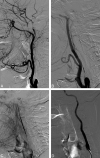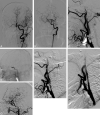Internal carotid artery stenting in patients with near occlusion: 30-day and long-term outcome
- PMID: 21051515
- PMCID: PMC7965724
- DOI: 10.3174/ajnr.A2285
Internal carotid artery stenting in patients with near occlusion: 30-day and long-term outcome
Abstract
Background and purpose: The natural history of the carotid NO is poorly characterized, and the management of patients remains controversial. We report the results and complications associated with CAS and follow-up.
Materials and methods: Between March 2000 and March 2009, 116 of 836 CAS procedures were performed in patients with carotid NO (13.9%). A total of 99 men (85.3%) and 17 women (14.7%) with a mean age of 65.8 years were included. Presenting symptoms were TIA in 44 patients (37.9%) and minor stroke or noninvalidating stroke in 61 (52.6%). One hundred five patients (90.5%) were symptomatic.
Results: A distal filter was used for cerebral protection in 92 patients (79.3%). Transient hemodynamic alterations were frequent during balloon inflation: hypotension (37.1%), bradycardia (48.3%), and asystole in 24.1%. Four patients (3.4%) developed a TIA after CAS. Stroke in progression was arrested in the 1 patient (0.9%). The median follow-up period for patients was 36 months. Asymptomatic restenosis >70% occurred in 5 patients (4.3%); asymptomatic occlusion occurred in 3 patients (2.6%). During follow-up, 3 patients (2.6%) experienced a stroke, 1 ipsilateral (at 19 months) and 2 contralateral (at 6 and 30 months, respectively). Thirteen patients (11.2%) died, 7 from vascular causes.
Conclusions: Our study showed that carotid NO is an under-recognized condition, and CAS would seem to be beneficial when performed by an experienced neurointerventional team.
Figures



Similar articles
-
Management of in-sent restenosis after carotid artery stenting in high-risk patients.J Vasc Surg. 2006 Feb;43(2):305-12. doi: 10.1016/j.jvs.2005.10.040. J Vasc Surg. 2006. PMID: 16476606
-
Perioperative and Follow-up Results of Carotid Artery Stenting and Carotid Endarterectomy in Patients with Carotid Near-Occlusion.Ann Vasc Surg. 2019 Aug;59:21-27. doi: 10.1016/j.avsg.2019.01.019. Epub 2019 Apr 19. Ann Vasc Surg. 2019. PMID: 31009714
-
Remote pre-procedural ischemic stroke as the greatest risk in carotid‑stenting‑associated stroke and death: a single center's experience.Int Angiol. 2017 Aug;36(4):306-315. doi: 10.23736/S0392-9590.16.03737-8. Epub 2016 Dec 1. Int Angiol. 2017. PMID: 27905692
-
Bilateral carotid angioplasty and stenting.Catheter Cardiovasc Interv. 2005 Mar;64(3):275-82. doi: 10.1002/ccd.20287. Catheter Cardiovasc Interv. 2005. PMID: 15736256
-
Ultrasound surveillance after CAS and CEA: what's the evidence?J Cardiovasc Surg (Torino). 2014 Apr;55(2 Suppl 1):33-41. J Cardiovasc Surg (Torino). 2014. PMID: 24796896 Review.
Cited by
-
Carotid artery stenting using the proximal or dual protection method for near occlusion of the cervical internal carotid artery.Neurosurg Rev. 2013 Oct;36(4):551-7; discussion 557-8. doi: 10.1007/s10143-013-0481-y. Epub 2013 Jun 21. Neurosurg Rev. 2013. PMID: 23793616
-
Carotid Near-Occlusion: A Comprehensive Review, Part 1--Definition, Terminology, and Diagnosis.AJNR Am J Neuroradiol. 2016 Jan;37(1):2-10. doi: 10.3174/ajnr.A4432. Epub 2015 Aug 27. AJNR Am J Neuroradiol. 2016. PMID: 26316571 Free PMC article.
-
Meta-analysis of the outcomes of treatment of internal carotid artery near occlusion.Br J Surg. 2019 May;106(6):665-671. doi: 10.1002/bjs.11159. Br J Surg. 2019. PMID: 30973990 Free PMC article.
-
Relevance of Distal Arterial Collapse in Stenting of Atherosclerotic Near-Occlusion of the Carotid Artery.AJNR Am J Neuroradiol. 2020 Jun;41(6):1054-1060. doi: 10.3174/ajnr.A6570. Epub 2020 Jun 4. AJNR Am J Neuroradiol. 2020. PMID: 32499248 Free PMC article.
-
Comparison of Carotid Endarterectomy and Stenting for Symptomatic Internal Carotid Artery Near-Occlusion.AJNR Am J Neuroradiol. 2019 Jul;40(7):1207-1212. doi: 10.3174/ajnr.A6085. Epub 2019 Jun 6. AJNR Am J Neuroradiol. 2019. PMID: 31171520 Free PMC article.
References
-
- Mehigan JT, Olcott C. The carotid “string sign”: differential diagnosis and management. Am J Surg 1980;140:137–43 - PubMed
-
- Morgenstern LB, Fox AJ, Sharpe BL, et al. . The risks and benefits of carotid endarterectomy in patients with near occlusion of the carotid artery: North American Symptomatic Carotid Endarterectomy Trial (NASCET) Group. Neurology 1997;48:911–15 - PubMed
-
- Rothwell PM, Warlow CP. Low risk of ischemic stroke in patients with reduced internal carotid artery lumen diameter distal to severe symptomatic carotid stenosis: cerebral protection due to low poststenotic flow? On behalf of the European Carotid Surgery Trialists' Collaborative Group. Stroke 2000;31:622–30 - PubMed
-
- O'Leary DH, Mattle H, Potter JE. Atheromatous pseudo-occlusion of the internal carotid artery. Stroke 1989;20:1168–73 - PubMed
-
- Ringelstein EB, Berg-Dammer E, Zeumer H. The so-called atheromatous pseudoocclusion of internal carotid artery: a diagnostic and therapeutical challenge. Neuroradiology 1983;25:147–55 - PubMed
Publication types
MeSH terms
LinkOut - more resources
Full Text Sources
Medical
